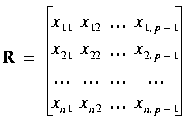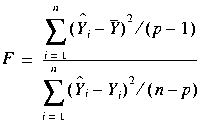 , we can say that in mathematical terms, Galton wanted to determine constants
, we can say that in mathematical terms, Galton wanted to determine constants

In the late 1880s, Francis Galton was studying the inheritance of physical characteristics. In particular, he wondered if he could predict a boy's adult height based on the height of his father. Galton hypothesized that the taller the father, the taller the son would be. He plotted the heights of fathers and the heights of their sons for a number of father-son pairs, then tried to fit a straight line through the data. If we denote the son's height by
![]() and the father's height by
and the father's height by
 , we can say that in mathematical terms, Galton wanted to determine constants
, we can say that in mathematical terms, Galton wanted to determine constants
![]() and
and
![]() such that:
such that:
![]() .
.
This is an example of a simple linear regression problem with a single predictor variable,
 . The parameter
. The parameter
![]() is called the intercept parameter. In general, a regression problem may consist of several predictor variables. Thus the multiple linear regression problem may be stated as follows:
is called the intercept parameter. In general, a regression problem may consist of several predictor variables. Thus the multiple linear regression problem may be stated as follows:
Let
![]() be a random variable that can be expressed in the form:
be a random variable that can be expressed in the form:
![]() ,
,
where
![]() are known constants, and
are known constants, and
![]() is a fluctuation error. The problem is to estimate the parameters
is a fluctuation error. The problem is to estimate the parameters
![]() . If the
. If the
![]() are varied and the
are varied and the
![]() values
values
![]() of
of
![]() are observed, then we write:
are observed, then we write:
![]() ,
,
where
![]() is the ith value of
is the ith value of
![]() . Writing these n equations in matrix form we have:
. Writing these n equations in matrix form we have:

or:
![]() ,
,
where
![]() .
.
We call the
![]() matrix
matrix
![]() the regression matrix,
the regression matrix,
![]() the response variable,
the response variable,
![]() the response vector, and
the response vector, and
![]() the predictor variable.
the predictor variable.
The method of least squares consists of minimizing
![]() with respect to
with respect to
![]() . Setting
. Setting
![]() , we minimize:
, we minimize:
![]()
subject to:
![]() .
.
Let
![]() be the least squares estimate of
be the least squares estimate of
![]() . The fitted regression
. The fitted regression
![]() is denoted by:
is denoted by:
![]() .
.
The elements of
![]() are called the residuals. The value of:
are called the residuals. The value of:
![]()
is called the residual sum of squares. The matrix:
 ,
,
which is the regression matrix without the first column of 1s, is called the predictor data matrix.
The variance of the model is defined to be the variance of
![]() . The statistic:
. The statistic:
![]()
is an unbiased estimator of this variance.
The dispersion matrix for the parameter estimates
![]() is the matrix
is the matrix
![]() , where
, where
![]() is the covariance of
is the covariance of
![]() and
and
![]() . The dispersion matrix is calculated according to the formula:
. The dispersion matrix is calculated according to the formula:
![]() ,
,
where
![]() is the estimated variance, as defined above, and
is the estimated variance, as defined above, and
![]() and
and
![]() are the regression matrix and its transpose, respectively.
are the regression matrix and its transpose, respectively.
The overall F statistic is a statistic for testing the null hypothesis
![]() . It is defined by the equation:
. It is defined by the equation:
 , where
, where
 .
.
This statistic follows an F distribution with (p-1) and (n-p) degrees of freedom.
The p-value is the probability of seeing the value of the F statistic for a given linear regression if the null hypothesis:
![]()
is true.
The critical value of the F statistic for a specified significance level,
![]() , is the value,
, is the value,
![]() , of the F statistic such that if the F statistic calculated for the multiple linear regression is greater than
, of the F statistic such that if the F statistic calculated for the multiple linear regression is greater than
![]() , we reject the hypothesis
, we reject the hypothesis
![]() at the significance level
at the significance level
![]() .
.
Let
![]() be the estimate for element j of the parameter vector
be the estimate for element j of the parameter vector
![]() . The T statistic for the parameter estimate
. The T statistic for the parameter estimate
![]() is a statistic for testing the hypothesis that
is a statistic for testing the hypothesis that
![]() . It is calculated according to the formula:
. It is calculated according to the formula:
 ,
,
where
![]() is the jth diagonal element of the dispersion matrix. This statistic is assumed to follow a T distribution with
is the jth diagonal element of the dispersion matrix. This statistic is assumed to follow a T distribution with
![]() degrees of freedom.
degrees of freedom.
The p-value for each parameter estimate
![]() is the probability of seeing the value of the calculated parameter using the formula in Section 3.2.5 if the hypothesis
is the probability of seeing the value of the calculated parameter using the formula in Section 3.2.5 if the hypothesis
![]() is true.
is true.
The critical value of a parameter T statistic for a given level of significance
![]() is the value
is the value
![]() , such that if the absolute value of the T statistic calculated for a given parameter
, such that if the absolute value of the T statistic calculated for a given parameter
![]() is greater than
is greater than
![]() , we reject the hypothesis
, we reject the hypothesis
![]() at the significance level
at the significance level
![]() .
.
Suppose that we have calculated parameter estimates
![]() for our linear regression problem. Suppose further that we have a vector of values,
for our linear regression problem. Suppose further that we have a vector of values,
![]() , for the predictor variables. We may obtain an
, for the predictor variables. We may obtain an
![]() level confidence interval for the value
level confidence interval for the value
![]() , which is the value of the dependent of the observed variable predicted by our model, according to the formula:
, which is the value of the dependent of the observed variable predicted by our model, according to the formula:
![]() ,
,
where
![]() is the value at
is the value at
![]() of the cumulative distribution function for a T distribution,
of the cumulative distribution function for a T distribution,
![]() is the estimated variance, and
is the estimated variance, and
![]() is the regression matrix.
is the regression matrix.
©Copyright 1999, Rogue Wave Software, Inc.
Contact Rogue Wave about documentation or support issues.